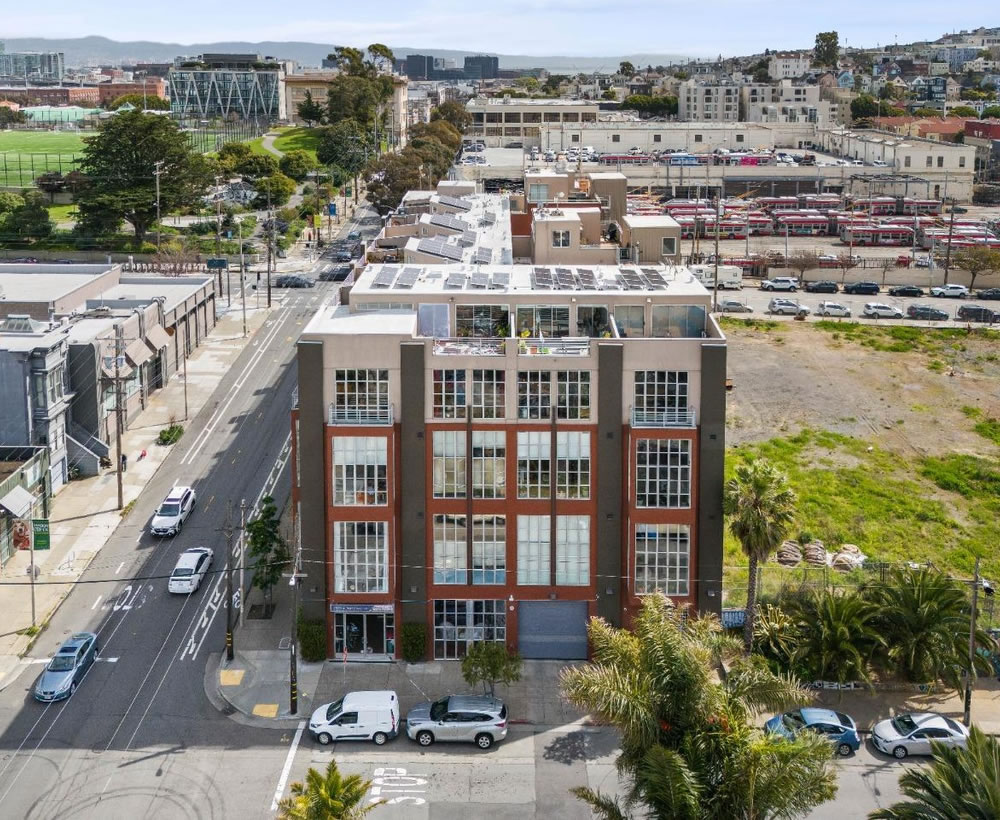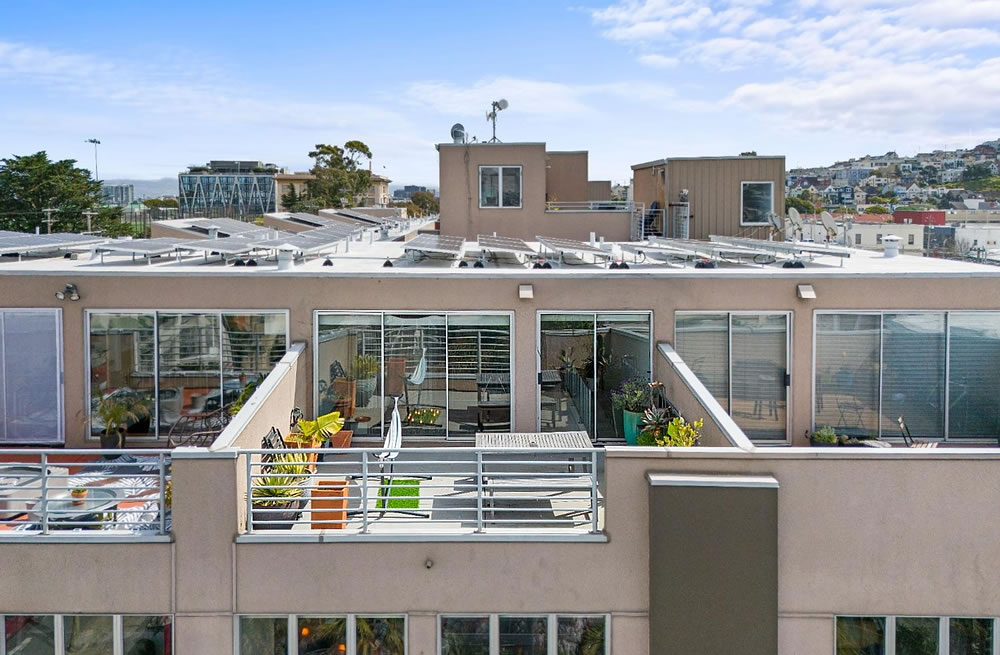Purchased for $1.15 million in March of 2020, which was the same price the top-floor Mission District loft fetched in August of 2017, as pictured below, the “amazing,” 949-square-foot unit #315 at 1800 Bryant Street returned to the market priced at just $1.099 million three months ago.
Offering “unparalleled urban living in the heart of San Francisco’s Mission District,” with “breathtaking views,” a private rooftop deck, and a coveted “open-concept layout [that] ensures an abundance of natural light,” along with a parking space, “steps away from some of San Francisco’s most beloved spots,” the list price for 1800 Bryant Street #315 was reduced to $999,000 in May.
And having just closed escrow with a contact price of $975,000, the resale of the “ideal” Mission District condo was officially “within 3 percent of asking!” and “over $1,000 per square foot!” according to all industry stats and aggregate reports but down 15.2 percent on an apples-to-apples basis, below its value in 2020 and in 2017 as well. And yes, the frequently misreported index for “San Francisco” condo values is “still up nearly 10 Percent!” over the same period of time.






Definitely, a couple of notches up from the basic whitebox. That said, the surrounding area is pretty mixed. Between the bus storage lot a block away and the vehicular junkyard next door, things look rough. StreetView shows a homeless encampment on the sidewalk in front of the neighboring property.
You clearly don’t live here, and should probably not comment based on your lack of actual working knowledge of the neighborhood. Your “Google Maps” version of research shows the extent of your ignorance, and that you are lazy and uninformed in any meaningful way. BTW, Your precious “Streetview” of the homeless tents IS FROM MARCH 2022…
That area is pretty okay (I live a few block away). In regards to the bus depot, there are plans for large project called Potrero Yards to begin fairly soon, 465 units over a rebuilt bus barn. The vacant lot next door has an approved project of some sort of a lab building, but I’m not sure about when it’s due to start. The development next door would likely displace the homeless encampment (if it’s even still there- the streetview image is from 2 years ago!)
If I were looking at the unit, the possibility of being surrounded by years long construction projects would raise more alarm bells than a couple of tents nearby.
It’ll be interesting if the SFMTA will end up executing the original plan for the bus yard redevelopment project, because last I read, it was supposed to include “513 below market rate (BMR) apartments…and a three-story bus garage designed to facilitate Muni’s transition to an all-electric fleet…”. If completed, it will be a wonderful rebuke to the private sector that often weasels its way out of development projects that include below-market rate homes on-site by saying sponsors are “releasing capital” from the sale of entitled projects before they are completed.
If completed, it will be a wonderful rebuke to the private sector that often weasels its way out of development projects that include below-market rate homes on-site
And if not completed …. or even started?? Would that then be an endorsement of the private sector pessimism?? Or may just recognition that an Agency that’s currently in a financial hole so deep it doesn’t need a ladder, but rather an assist from Spacex, to reach the top is perhaps ill suited to branching out into RE development.
Sure. I think failure would be similar to the private sector’s excuses and inability to follow-through. The “financial hole” you mentioned isn’t due to the cost of this sorely needed project (the current yard was built in 1915 and doesn’t meet modern seismic safety standards), but because revenue from ridership fares is only 56 percent of what it was pre-pandemic, while revenue from parking fees dipped by 12 percent. The project is being led/managed by Plenary Americas, which I don’t think is “ill suited to branching out into RE development” any more than Lendlease was or is suited to completing the 540-foot tower at Hayes Point.
That’s good to know, since SF’s recent transit project haven’t inspried confidence (at least financially speaking). Still I have to think there’s a certain amount of Muni-expense, even if it’s only “liasoning” with the defacto developer. So probably not the best timing, need and case (of deficits) notwithstanding.
I’m nearby too – there’s always folks camped on Florida in front of the empty lot, though once they begin construction on the lab space, I wouldn’t expect that to persist.
Okay, I looked around to see why there was a difference between the number of housing units this site reported for the Potrero Yard bus facility last year and the number mentioned by ‘paulH’, above. The Chronicle posted an article a few months ago, bylined by business desk reporter Roland Li, with the headline Why one of S.F.’s biggest housing projects could shrink by hundreds of affordable apartments and said this, starting with the second ‘graph:
Since the money for the housing element of the project hasn’t been identified, and as the story says in a later ‘graph, “the SFMTA cannot spend transit money for a housing project that doesn’t generate money for transit”, people who suspect that the housing portion of the project will be dispensed with in the near future will probably look prescient.
I was going off an article in mission local from earlier this year; https://missionlocal.org/2024/01/potrero-yard-missions-largest-affordable-housing-shrinks-to-465-units/ Towards the end of the article there is mention of a 104 unit backup plan if funding isn’t secured: “The alternative 104-unit plan would extend the planned four-story bus yard into a fifth story, adding a paratransit vehicle yard above. Von Krogh stressed that the plan is only a backup if the agency does not secure enough funding for the 465-unit project after the initial bus-yard construction.”
That article starts out by informing readers that the unit count for the project had already shrunk from the 513 proposed in October 2023 to 465 in January of this year. Given the current fiscal realities, I would place the probability of SFMTA securing the necessary funding for the currently planned full 465-unit project before the end of 2025 at under fifteen percent.
Recall that there was a much-lauded plan to build 63 units of affordable housing for teachers at 18th and Mission streets that was scheduled to break ground this year. The ground breaking was “delayed due to insufficient funding”, in spite of $12 million from Proposition I last July. And the housing pipeline just keeps getting longer and longer.